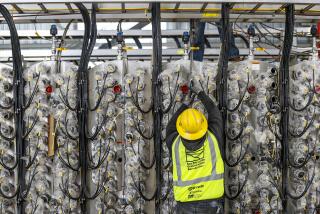EPA Takes Control of Coast DDT Site
Taking the unprecedented step of declaring the ocean off Southern California a Superfund project, the U.S. Environmental Protection Agency announced Wednesday that it has assumed command of the cleanup of a major DDT deposit that has poisoned marine life for decades.
The EPA will investigate options for reducing the dangers posed by the 100 tons of DDT dumped on the ocean floor off the Palos Verdes Peninsula, and plans to select a short-term solution within a year for the most highly contaminated spots.
The deposit--considered the most problematic and persistent case of ocean pollution in the country--is still harming bald eagles, peregrine falcons, fish, dolphins and other marine life a quarter century after the pesticide was banned, according to government-hired scientists.
Devising a remedy for the world’s largest deposit of DDT, which flowed from the now-defunct Montrose Chemical Corp. plant near Torrance, is considered a huge challenge because it sprawls across 27 square miles of the deep ocean floor.
No ocean area except contained harbors has ever been declared a Superfund site and made part of the government’s program for cleaning up the worst pollution. The long-delayed decision is welcomed by many state and local officials and environmentalists, who say it will hasten the remedy of an ecological problem that has lingered too long.
EPA assistant regional counsel John Lyons said the decision was spurred by the “severity of the conditions out there on the Palos Verdes shelf.” EPA documents released Wednesday called the deposit a high risk to marine life and to people who eat fish caught there.
“This is a significant problem offshore, both in terms of the threat to the environment and to public health, so we’re turning to the full guns of the Superfund arsenal to address this,” Lyons said.
From 1947 to 1971, Montrose Chemical Corp. flushed several million pounds of DDT into the county sewer system that empties off the Palos Verdes Peninsula, according to government records. The widely used pesticide was banned in the United States in 1972 after it accumulated in the food chain, decimating birds worldwide and posing a cancer and reproductive risk to people.
In designing its remedy, EPA officials will focus initially on hot spots high concentrations of DDT and PCBs in a three-square-mile area off White’s Point, under 300 feet of ocean water.
Their most likely decision will be to cap those spots with sand and other material dredged from the Port of Los Angeles during port expansion. Such a containment has never been tried in the deep ocean, and the EPA must first determine if it is too risky or costly.
The EPA also is mounting a search for a long-term solution for the entire site.
In 1990, the Justice Department sued Montrose and several other companies to clean up the contamination and restore wildlife, but the case was dismissed last year by a federal judge and since has been bogged down in an appeal. By tapping the Superfund, the EPA has a readily available pool of cleanup money and more power to go after businesses for reimbursement.
“It’s fantastic news for the bay,” said Mark Gold, executive director of Heal the Bay. “This is the bay’s black eye that never healed. Superfund has a lot more authority to get things done. Nothing was going to happen with that [Justice Department] case in this century.”
Because the EPA would only cover possible cleanup costs, the Justice Department will continue its suit seeking millions of dollars in damages for restoring injured wildlife and resources.
Montrose--which no longer is in business but has hired a battery of attorneys and scientific experts--has strenuously fought the government’s allegations. The company contends that the DDT deposit is buried under a thick layer of sewage sediment and is degrading naturally so capping or removing it is unnecessary and risky.
“I’m hopeful that EPA will do exactly what it said it’s going to do and take a fresh look at the situation and make a decision about what, if any, remedial actions should be taken based on a realistic assessment of what risk actually exists,” said Karl Lytz, a San Francisco attorney representing Montrose.
EPA officials, however, rejected Montrose’s main arguments as implausible, saying the deposit is posing a major danger. Lyons said the agency is especially worried about people who ignore state warnings and eat highly contaminated white croaker caught off the peninsula.
Mike Montgomery, the EPA’s project manager for the site, said his agency, which is often criticized for moving slowly at Superfund sites, plans a fairly quick turnaround in this case.
“Our objective is to reduce the DDT and PCBs in fish found on the shelf,” Montgomery said. “We are not necessarily focusing on a complete restoration of the shelf but bringing the risk to what we consider an acceptable level.”
DDT in some fish on the Palos Verdes shelf is four times above the safety level set by the Food and Drug Administration, the new EPA documents say. Eating one serving per week poses a risk of one cancer case per 1,000 people exposed--about 1,000 times times the acceptable level, the agency says.
(BEGIN TEXT OF INFOBOX / INFOGRAPHIC)
Chemical Solution
The U.S. Environmental Protection Agency will take over cleanup of a DDT deposit that has been poisoning marine llife off the Palos Verdes Penninsula for decades.
More to Read
Sign up for Essential California
The most important California stories and recommendations in your inbox every morning.
You may occasionally receive promotional content from the Los Angeles Times.










